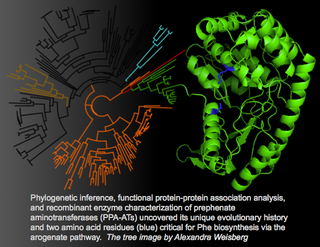Research Interests in Maeda Lab
Maeda Lab at University of Wisconsin-Madison studies evolutionary diversification of core metabolic pathways (i.e. primary metabolism) in various plants through chemical, biochemical, genetic, and evolutionary analyses. Utilizing the acquired basic knowledge, we further aim to redesign plant metabolic network and improve chemical compositions of agricultural and bioenergy crops, such as for improved food nutrition, plant-based bioenergy and pharmaceutical production.
Plants produce a diverse array of secondary (specialized) metabolites, which play critical roles in plant adaption to various ecological niches. In contrast to well-documented diversification of plant secondary metabolism, primary metabolism, which provides precursors of secondary metabolites, is generally thought to be conserved across different plant species. However, our lab has uncovered lineage-specific diversifications of primary metabolic pathways in different plant groups, likely to support downstream synthesis of diverse secondary metabolites (Schenck et al. 2015; 2017a; Lopez-Nieves et al. 2018; 2022; Maeda 2019a). Such basic knowledge of the interface between plant primary and secondary metabolism will be crucial for future breeding, metabolic engineering, and synthetic biology to improve sustainable production of natural and bio-products from CO2 using plants as chemical production platforms (Maeda 2019b).
We are conducting various projects that primarily focus on aromatic amino acid biosynthesis, which connects central carbon metabolism and diverse plant natural product pathways. We are further i) exploring other examples of primary metabolic diversity in the aromatic amino acid pathways, ii) investigating underlying genetic and biochemical mechanisms, iii) utilizing the knowledge to engineer aromatic amino acid biosynthesis and improve precursor metabolite availability, and iv) analyzing physiological impacts of metabolic engineering on plant growth and development. More recently, we are investigating how nitrogen (N) flow through plant metabolic network via a large and ancient enzyme family of aminotransferases (ATs)
Evolutionary Diversification of Tyrosine Biosynthesis and Downstream Natural Product Pathways
- Primary metabolites are indispensable cellular components that directly impact plant growth and development. Consequently, primary metabolic pathways are evolutionarily constrained, typically conserved among the plant kingdom, and difficult to manipulate. Our lab, however, uncovered lineage-specific diversification of a primary amino acid pathway, tyrosine biosynthesis, in legumes (Schenck et al. 2015; 2017a; 2017b; Maeda 2019a). We also revealed that de-regulation of tyrosine biosynthesis occurred at the base of core Caryophyllales and facilitated later evolution of a novel pigment pathway, betalain biosynthesis (Lopez-Nieves et al. 2018).
- Combining evolutionary biochemistry, metabolomics, and phylogenomic analyses, we are further exploring evolutionary alterations of tyrosine biosynthesis and their impacts on associated metabolic network in various plant lineages. The study can advance our understanding of the step-wise evolution of complex metabolic traits at macroevolutionary scale and explore how the evolution of such traits influence subsequent adaptation and diversification in plants. As a part of broader impact activity, we will be also generating chemotaxonomic databases together with students to study evolutionary history, mechanism, and functions of tremendous chemical diversity that exist in the plant kingdom.
- Collaborators: Michael McKain (Univ. Alabama), James Leebens-Mack (Univ. Georgia), Ya Yang (Univ. Minnesota), Samuel Brockington (Univ. Cambridge), and Stephen Smith (Univ. Michigan)
- Read more at our NSF PGRP project website :
Regulation of the Shikimate and Aromatic Amino Acid Pathways in Plants
- The shikimate pathway directs carbon flux from central carbon metabolism (e.g. Calvin-Benson cycle, glycolysis) to biosynthesis of aromatic amino acids (AAAs) and numerous AAA-derived plant natural products (Maeda and Dudareva, 2012). However, it is unknown how plants regulate the shikimate pathway. We are investigating molecular mechanisms underlying de-regulation of plant AAA biosynthesis and analyzing their quantitative impacts on overall plant metabolic network. Here we are utilizing enzyme biochemistry, forward and reverse genetics, 13CO2 labeling, and structure-function enzyme analyses, as well as metabolic pathway modeling. The obtained enzyme variants and knowledge can be used to boost the production of AAAs and their derived natural products in plants.
- Collaborators: Joseph Jez (WUSTL), Alisdair Fernie (MPI-Golm), Mark Stitt (MPI-Golm), Zoran Nikoloski (Univ. Potsdam/MPI-Golm)
Crop-Based Production of Natural Products through Synthetic Biology
- Plant natural products provide valuable nutraceuticals, pharmaceuticals, and bio-products. Global crop production systems provide sustainable and potentially efficient chemical production platforms, as plants can naturally produce and store abundant chemicals. However, little effort has been made to identify and build plant hosts or chassis for sizable production of natural products.
- We are addressing two outstanding questions thwarting this issue: i) Which plants serve as efficient chemical production platforms and ii) what is the contribution of primary metabolite precursor supply for natural product synthesis? Utilizing our de-regulated tyrosine biosynthetic enzymes (Schenck et al. 2015; 2017; Lopez-Nieves et al. 2018) we are conducting proof-of-concept experiments by expressing tyrosine-utilizing enzymes in transgenic Arabidopsis and other crops accumulating different levels of tyrosine. The study will generate prototype crops for nutrient-enriched functional food, feed, and natural dye, and also lay essential groundwork towards crop-based production of natural and bio-products.
- Collaborator: Wisconsin Crop Innovation Center (WCIC)
Amino Acid Sensing and Response Mechanisms in Plants
- The long-term goal of the Maeda laboratory is to improve the production of amino acids and amino acid-derived plant natural products. Perturbation of amino acid metabolism, however, often leads to pleiotropic growth and developmental responses and very little is known how amino acid homeostasis is regulated and linked to plant growth and development. We previously isolated partially tyrosine-deficient tyra2 mutants as well as tyrosine hyper-accumulating lines of Arabidopsis, both of which exhibit compromised growth and unique reticulate leaf phenotypes (de Oliveira et al. 2019). These findings suggest that imbalance of aromatic amino acids impacts plant growth and development. Here we are conducting physiological, genetic, and biochemical analyses to elucidate mechanisms underlying these pleiotropic plant responses to amino acid imbalance. Fundamental understanding of amino acid homeostasis mechanisms will enhance plants’ resilience to amino acid perturbation and hence have broad impacts on improving yield and nutritional quality of crops.
Defining the Nitrogen Flux Maps (NFMs) of Plants <DOE BER project website>  - Nitrogen (N) is a critical element of organic molecules, including aromatic amino acids, but is highly limited in plants. Thus, N use efficiency directly impacts overall yield and performance of plants. Unlike extensively-studied carbon (C) flux map of plant metabolism,little is known how assimilated N flows through the metabolic network, namely “N flux map (NFM)”. The core of NFM is different branches of amino acid metabolism interconnected by aminotransferases (ATs), which play pivotal roles in distributing reduced N for synthesis of various organonitrogen compounds (Dornfeld et al., 2014; Wang et al., 2016; Wang and Maeda, 2017; Wang et al., 2019). Utilizing the wealth of sequenced plant genome information, high-throughput gene and protein syntheses, and enzyme assay platforms, we aim to determine multi-substrate specificities of all ATs from different plant species and construct NFMs from Arabidopsis and Sorghum. The resulting NFMs will provide foundation to further optimize N metabolic network and to generate plants that can produce high levels of N-containing compounds (e.g. alkaloids) while maintaining robust growth even in reduced N fertilizer.
- Collaborators: Trent Northen (LBNL/JGI), Yasuo Yoshikuni (LBNL/JGI), Zoran Nikoloski (Univ. Potsdam/MPI-Golm), Taichi Takasuka (Hokkaido Univ.)
- Our studies are supported by UW-Madison, NSF, USDA NIFA, and DOE BER.
COMPLETED PROJECTS
Defining the Tyrosine Biosynthetic Pathways in Plants
Funded by NSF IOS grant-1354971, 9/01/2014 – 8/31/2018
 - This project uncovered unique diversification of the primary amino acid pathway—tyrosine biosynthesis—in different plants, likely to support tremendous chemical diversity of tyrosine-derived natural products ([[Maeda_Lab:Publications |Schenck and Maeda, 2018). We found that Arabidopsis makes tyrosine mainly via plastidic arogenate dehydrogenase (TyrAa) enzymes (Wang et al., 2016; de Oliveira et al., 2019; Wang 2019), whereas legumes have an additional alternative tyrosine pathway catalyzed via a novel feedback-insensitive prephenate dehydrogenase (TyrAp) enzymes ([[Maeda_Lab:Publications |Scheck et al., 2015, 2017a). Phylogeny-guided structure-function analyses of plant and microbial TyrA enzymes further identified a single aspartate residue that confers arogenate dehydrogenase activity and simultaneously affects tyrosine inhibition (Schenck et al., 2017a; 2017b). The project also provided rigorous independent research opportunities for ten undergraduate students and conducted “Pigment-Art” outreach activity to inform general public about the nutritional and pharmacological values of plant natural products (see our (outreach page).
Elucidation of the Tyrosine Pathway in Table Beets
Funded by USDA NIFA grant-2015-67013-11631139, 3/01/2015 – 2/28/2019)
- Table beets uniquely accumulate high levels of tyrosine-derived red/yellow pigments, betalains (Wang et al., 2017). Similar to Arabidopsis, beets (Beta vulgaris) had two genes (BvTyrAα and BvTyrAβ) encoding plastidic arogenate dehydrogenase (TyrA) enzymes. Interestingly, however, BvTyrAα but not BvTyrAβ exhibited reduced sensitivity to tyrosine inhibition (Lopez-Nieves et al., 2018). Detailed phylogenetic analysis of BvTyrAα and BvTyrAβ orthologs identified from transcriptome data of nearly one hundred Caryophyllales plants showed that BvTyrAα orthologs emerged prior to the appearance of betalain pigmentation. The results suggest that a lineage-specific de-regulation of primary metabolism (i.e. tyrosine biosynthesis) facilitated the evolution of downstream betalain biosynthesis (Lopez-Nieves et al., 2018) and various natural product pathways derived from tyrosine (Lopez-Nieves et al., In preparation). The identified de-regulated BvTyrAα enzymes can be further utilized to enhance the availability of the tyrosine precursor and the production of tyrosine-derived natural products (Timoneda et al., 2018; Maeda 2019b).
Evolution of Plant Phenylalanine Biosynthesis
 - In plants, phenylalanine (Phe) is a precursor of abundant and diverse phenylpropanoid compounds, such as flavonoids, tannins, and lignin. Plants synthesize Phe predominantly via the arogenate pathway (Maeda et al., 2010; 2011) in contrast to model microbes (e.g. E. coli) that use exclusively the phenylpyruvate pathway for Phe biosynthesis. Together with Dr. John Jelesko at Virginia Tech, we conducted phylogenetically-informed biochemical characterization of prephenate aminotransferase (PPA-AT), which catalyzes the first committed step of the arogenate pathway, and uncovered a unique evolutionary history of the arogenate Phe pathway. Our results revealed that prephenate-specific aminotransferase containing Thr84 and Lys169 was transferred from a Chloribi/Bacteroidetes ancestor to a eukaryotic ancestor of the Plantae. This ancient lateral gene transfer likely led to efficient Phe production via the arogenate pathway, which currently supports the production of abundant phenylpropanoid natural products such as lignin. (Dornfeld et al., 2014)
|






